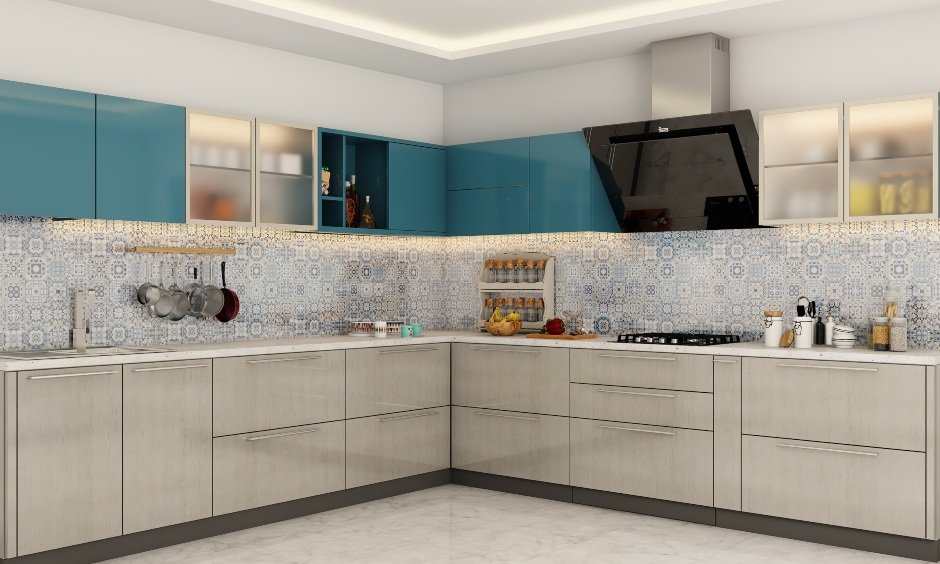Embrace Moroccan tiles and embark on a journey of creating a kitchen that truly reflects your style and personality.
The kitchen is the heart of any home, where cherished memories are created, and family bonds are strengthened. If you want to infuse exotic elegance into this vital space, consider the Moroccan kitchen tiles. With their intricate patterns and timeless appeal, they have been captivating homeowners for centuries. So, let’s dive into the pros and cons of using these tiles in your kitchen and see if they are the perfect fit for your culinary sanctuary.
Pros of Using Moroccan Tiles for Kitchen
Versatile Usage of Moroccan Kitchen Tiles: Floor to Backsplash
One of the greatest advantages of these tiles is their versatility. They can be used not only on the kitchen floor but also on the exquisite Moroccan tile patterns that make for a stunning backsplash. Whether you want to add an artistic touch to the entire floor or create a captivating focal point behind your stove, think exotic tiles.

Timeless and Classic Appeal of Moroccan Style Tiles
Tiles can bring a timeless and classic charm to any kitchen. Take the kitchen shown in the image below, for instance. The bright and vibrant hues of these best Moroccan tiles add much-needed life to this otherwise pale kitchen. These tiles never go out of style thanks to their intricate geometric patterns and rich colours, making them a fantastic choice for homeowners who seek enduring elegance.

Highly Durable Moroccan Floor Tiles for Long-Lasting Beauty
Tiles are renowned for their durability, ensuring they withstand the test of time, even in high-traffic kitchen areas like kitchens. So, although handmade Moroccan floor tiles are expensive, investing in them means you can enjoy their beauty for many years without worrying.

Cons of Using Moroccan Tiles for Kitchen
Moroccan Style Tiles Are an Expensive Investment
The intricate craftsmanship and premium quality of these kitchen tiles come with a hefty price tag. So, if you are on a tight budget, they may not be the most cost-effective option for your kitchen. Instead, you can opt for ceramic tiles with a Moroccan tile pattern.

Extra Care and Maintenance of Blue Moroccan Tiles
Maintaining the lustre and charm of these tiles requires proper care. Regular cleaning and sealing are essential to prevent damage and keep them looking their best. Use vinegar and warm water for routine cleaning and gently scrub with a soft cloth. Vacuum cleaners can also be used safely. However, mix water and bicarbonate soda for tough stains and gently scrub the spots.

Innovative Modular Kitchen Designs
Limited Colour Options
Moroccan tiles come in a stunning array of colours, but they are limited to a specific palette, typically including white, black, red, green, blue, yellow, brown, grey, and pink. If you have a specific colour scheme in mind, the options are somewhat restrictive.

In conclusion, Moroccan tiles have the power to transform your kitchen into a mesmerising masterpiece. Their versatility, timeless charm, and durability make them an excellent choice for those seeking exotic elegance. However, it’s essential to consider your budget and maintenance commitment before taking the plunge.
Book a free consultation with our in-house interior designers to explore the enchanting world of kitchen tiles and discover how they can elevate your space’s design. They will guide you through the process, helping you make an informed decision that aligns with your taste and lifestyle. Don’t forget to check our blog section for more design inspiration and valuable tips.
Also, Check Out Our Premium Modular Kitchen Designs
FAQs On Moroccan Tiles Designs
1. Can Moroccan tiles be used on kitchen countertops?
Absolutely! Moroccan tile design can make any dull kitchen pop with its vibrancy and liveliness.
2. Are Moroccan tiles slip-resistant?
Yes, many Moroccan tiles are slip-resistant. A tile’s slip resistance is determined by its surface texture and finish. These tiles, especially those designed for flooring, often feature a slightly textured surface that provides better traction, reducing the risk of slips and falls. Additionally, using proper sealants, you can make your kitchen tiles adequately slip-resistant.
3. Do Moroccan tiles require any special installation techniques?
Yes, Moroccan tiles may require special installation techniques, especially if they feature intricate patterns or designs. Here are some things you should consider before installing these tiles:
- Level Substrate: It is essential to have a level and smooth substrate before laying the tiles. Any unevenness in the surface can affect the tiles’ alignment and lead to unsatisfactory results.
- Tile Spacers: These tiles often have intricate patterns with small gaps between each tile. To maintain the design’s integrity, tile spacers are crucial during installation to ensure even spacing and alignment.
- Sealing: These tiles are porous; some may require sealing to protect them from moisture and stains.
- Grouting: Proper grouting is vital to ensure a cohesive and seamless look. The grout colour should complement the tiles’ design and enhance their appearance.
- Cutting and Trimming: These tiles may require cutting or trimming to fit specific areas, especially near edges, corners, or irregular spaces. Special cutting tools and techniques may be necessary to achieve precise cuts without damaging the tiles.
4. Are Moroccan tiles environmentally friendly?
Yes, Moroccan tiles are eco-friendly as they are made out of clay.
5. Are Moroccan tiles heat-resistant?
Moroccan tiles are heat-resistant to a certain degree. They are made of clay, which is a naturally heat-resistant material. However, the degree of heat resistance will vary depending on the type of tile.
| Type of Moroccan Tile | Heat Resistance (°C) |
| Glazed Tiles | 100-150°C |
| Unglazed Tiles | 60-100°C |
| Terracotta Tiles | 50-80°C |



















